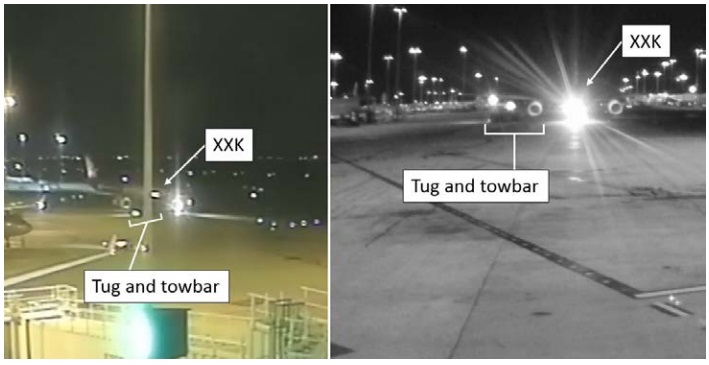A330 Starts to Taxi Before Tug is Clear
In the early hours of 9 September 2016 AirAsia X Airbus A330-343X 9M-XXK pushed back from gate D12 at Melbourne Airport, Victoria. The Australian Transport Safety Bureau (ATSB) say in their safety investigation report that:
The aircraft maintenance engineer (AME) conducting the pushback was provided by a contracted company, the tug and tug driver were provided by a third company. At 0008, after both engines were started, the AME disconnected the headset and tow bar from both the aircraft and the tug, the AME also removed the bypass pin. The tug driver turned the tug around to allow the AME to attach the tow bar to the rear of the tug.
The tug driver then moved the tug and tow bar to a position forward of the aircraft’s right engine and visible to the first officer. The AME then walked to a position in front of the tug, and displayed the bypass pin to the first officer.
Sighting the bypass pin was the final item on the flight crew’s after start checklist. The flight crew then contacted ATC and obtained a taxi clearance.
At 0009, the first officer confirmed to the captain that the AME and tug were clear, the captain then began to taxi. At this time, the AME was walking towards the left side of the tug, which remained parked forward of the aircraft’s right engine and wing.
As the AME walked, they detected the aircraft’s taxi light illuminate and the aircraft begin to move. The AME then ran toward the tug door and alerted the tug driver to the aircraft movement.
Air Asia X A330 9M-XXK starts to taxy with tug still in front of wing (Credit: Melbourne Airport video annotated by ARSB)
Video footage of the incident shows the tug driver taking action to avoid a collision with the taxiing aircraft.
The ATSB explain that the flight crew procedures included the following steps:
- After the pushback and engine start sequence is complete, the bypass pin must be sighted.
- Once taxi clearance is obtained, the flight crew shall ensure both sides of the aircraft are clear prior to taxi
The ground handling procedures include the following steps:
- Once the tow bar is connected to the tow vehicle (after being disconnected from the aircraft), the tow vehicle must move away to an area that is visible to the flight crew.
- At a suitable and safe distance from the aircraft, (the AME must) hold up the bypass pin to provide visual confirmation that it has been removed to the flight crew and give a ‘thumbs up’ signal indicating ‘clearance to proceed’. Once acknowledged by the flight crew, move away from the aircraft to a safe distance for the aircraft to taxi.
The ATSB report that:
The tug driver and AME both commented that they expected the aircraft to remain stationary until they had moved clear of the S7 disconnect point boundary.
The flight crew commented to the ATSB:
- Both flight crew interpreted the AME displaying the bypass pin as meaning the tug and AME were clear, and it was safe to commence taxi.
- The flight crew assumed that ATC providing the taxi clearance meant that ATC had confirmed the tug was clear of the aircraft.
- The first officer observed the tug and AME to the right of the aircraft and assessed that they were clear of the right engine.
The ATSB say that before this incident:
In 2015, ATC provider, Airservices Australia, identified some misinterpretation among pilots, airside drivers and ground crew regarding the responsibilities for collision avoidance on aerodrome movement areas and the services ATC provide to aircraft and/or vehicles operating on these areas. In response, on 12 November 2015, Airservices Australia released an Aeronautical Information Circular AIC (H32/15) and subsequently in 15 March 2016, this information was released as a safety bulletin, Safety of ground movement on a controlled aerodrome. The bulletin had been provided to the operators involved in this incident.
ATSB Safety Analysis
The misunderstandings by the parties involved during this sequence likely led to incorrect expectations of when the aircraft would begin taxi and the aircraft beginning to taxi prior to the tug moving clear. The flight crew procedures required the flight crew to visually confirm that all ground equipment was clear of the aircraft prior to taxi. The first officer assessed that the tug and tow bar were clear of the right engine when they were not, although their perception may have been influenced by an expectation of them being clear given the communications with the AME and ATC providing taxi clearance.
ATSB Safety Message
The ATSB comment that:
This incident highlights the importance of separate operators working closely together and having procedures which are well harmonised. It is also important that these procedures are well understood and practised by all individuals involved from the different operators to ensure all parties understand their role but also how their role interacts with other parties.
Other Safety Resources
Other Aerossurance articles include:
- A320 Collided with Two De-Icing Trucks Misinterpretation of communication due to a lack of standardised phraseology was a factor in this incident say the BFU, when an A320 attempted to to return to stand after a checklist error.
- Ground Collision Under Pressure: Challenger vs ATV: 1-0 Pressure, changes of plan and distractions all feature in this ground collision where a Challenger overturned an All Terrain Vehicle.
- A320 Rolls Back on Stand: Incomplete Maintenance Procedures and Ground Handling Deviations: The brakes had been set OFF during maintenance trouble shooting and the chocks removed prematurely, so the aircraft rolled when a tug with a u/s radio was being swapped out.
- Jetstar Dispatcher Forced to Run After Distracted Pushback A dispatcher was forced to run when an aircraft started to taxi while he was still connected to it after the crew became distracted, skipped procedural steps and misidentified the dispatcher.
- UPDATE 12 October 2020: Runaway Dash 8 Q400 at Aberdeen after Miscommunication Over Chocks
Aerossurance is pleased to sponsor the 9th European Society of Air Safety Investigators (ESASI) Regional Seminar in Riga, Latvia 23 and 24 May 2018.




Recent Comments